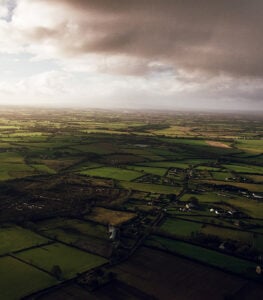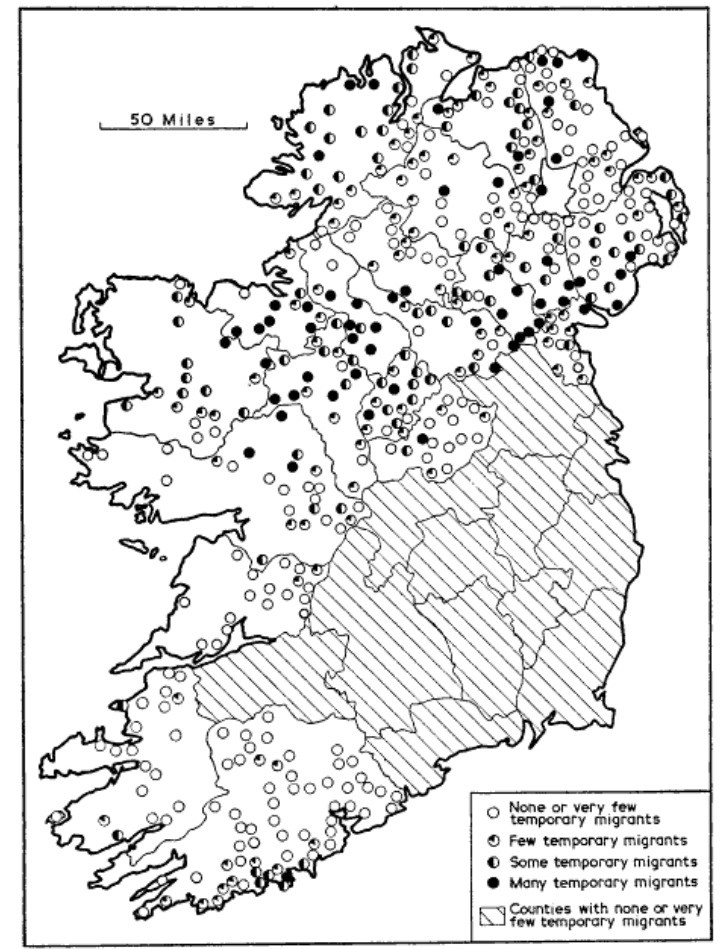 How did our Irish tenant ancestors earn the money they needed to pay their yearly rent? One possibility: they travelled to Great Britain to work for the summer.
How did our Irish tenant ancestors earn the money they needed to pay their yearly rent? One possibility: they travelled to Great Britain to work for the summer.
One study in 1834 looked at where in Ireland migrant workers could be found. This map illustrates that many of these workers came from the poorer parts of Ireland in the west or north, where travel to the ports of Londonderry and Belfast was relatively easy:1

Access to a port city was important for migrant workers at this time. Before railroads were available, most migrant workers traveled on foot. But once they arrived at a port, they could take advantage of the steamships which regularly sailed to Britain. One newspaper ad from 1845 stated that the steerage fare from Londonderry to Glasgow was 2 shillings and 6 pence, and the sea voyage generally took 12 to 14 hours.2 Similar ships left from Belfast, Dublin, and other larger ports.
Be aware that no passenger lists were kept for these steamship journeys. At the time, sailing between Ireland and Great Britain was considered internal domestic travel. Instead, you might want to search for British newspaper reports which mention “Irish agricultural labourers.” You may find stories of these migrant workers and the conditions they encountered.
Irish migrant work continued well into the 1900s. An account from Donegal in 1909 described a common situation for a newlywed Irish couple:
“[The] bridegroom goes off to Scotland, while the bride brings her sister or some other female relative to stay with her. All the summer and harvest the young [husband] toils in Scotland, and then comes home for a few months in the winter. In this way a young pair, who perhaps had not £5 when they got married, will live and rear a family of a dozen or more children . . . when the boys reach nine or ten years of age they hire out in the neighbourhood for herding, and then after the age of twelve or thirteen they hire out with farmers . . . later they go to Scotland with their father, if he is still alive, and about the age of twenty they marry like their parents, and thus life goes on." 3
Do you think your Irish ancestors were migrant workers? I'd love to hear about them and their lives.
Notes
1 J.H. Johnson, Harvest Migration from Nineteenth-Century Ireland in Transactions of the Institute of British Geographers, No. 41 (Jun 1967), p. 100; JSTOR.
2 Coleraine Chronicle, 1 Mar 1845, p. 3, col. 6; “Irish Newspapers,” FindMyPast.
3 Varia in Béaloideas, No. 9 (Dec 1939), p 293; JSTOR.
Share this:

About Pam Guye Holland
Pam has been researching family roots in Ireland, Massachusetts, New York, Ohio, and Germany for over twenty years. She is the genetic genealogy director for the Massachusetts Genealogical Council and is a certificate holder from the Boston University Genealogical Research Certificate program. She lectures internationally, is a regular contributor to the NEHGS blog, Vita-Brevis, and has published articles on genetics and genealogy in the American Ancestors magazine. A native of Cleveland, Ohio, she grew up in West Virginia, and currently resides in the Boston area. During her earlier career she earned a BA in International Relations from the College of Wooster and a MS in Computer Science from Northeastern University. Areas of expertise: Irish immigration, Irish records, DNA, church records, German, New York (both city and state), and New England.View all posts by Pam Guye Holland →